Why the size of the needle of a syringe controls flow rate better than the thumb pressure exerted by a doctor while administering an injection?
Step-by-Step Solution:
1. Understanding the Question: The question asks why the size of the needle in a syringe is more effective in controlling the flow rate of a fluid than the thumb pressure applied by a doctor.
2. Identifying Key Concepts: The key concepts involved in this question are:
- The cross-sectional area of the needle
- The relationship between area and flow rate (Equation of Continuity)
- The role of velocity in fluid flow
3. Cross-Sectional Area of the Needle: The needle of a syringe has a very small cross-sectional area compared to the thumb pressure applied by the doctor. This small area allows for more precise control over the flow of the fluid.
4. Equation of Continuity: According to the equation of continuity, the product of the cross-sectional area (A) and the velocity (v) of a fluid remains constant along a streamline. This can be expressed as:
A1v1=A2v2
where A1 and v1 are the area and velocity at one point, and A2 and v2 are the area and velocity at another point.
5. Effect of Needle Size on Flow Rate: When the cross-sectional area of the needle decreases (as it does in a syringe), the velocity of the fluid must increase to maintain the continuity of flow. This means that:
- If the area decreases, the velocity increases (i.e., A↓⇒v↑).
- This increased velocity results in a smoother and more controlled flow of the fluid.
6. Conclusion: Therefore, the size of the needle allows for a more controlled and precise delivery of the fluid compared to the variable thumb pressure exerted by a doctor. The small cross-sectional area of the needle ensures that the flow rate is primarily determined by the needle size rather than the pressure applied.
Final Answer:
The size of the needle of a syringe controls the flow rate better than the thumb pressure exerted by a doctor because the small cross-sectional area of the needle increases the fluid velocity, leading to a smoother and more precise flow, as described by the equation of continuity.
---
- The cross-sectional area of the needle
- The relationship between area and flow rate (Equation of Continuity)
- The role of velocity in fluid flow
A1v1=A2v2
where A1 and v1 are the area and velocity at one point, and A2 and v2 are the area and velocity at another point.
- If the area decreases, the velocity increases (i.e., A↓⇒v↑).
- This increased velocity results in a smoother and more controlled flow of the fluid.
The size of the needle of a syringe controls the flow rate better than the thumb pressure exerted by a doctor because the small cross-sectional area of the needle increases the fluid velocity, leading to a smoother and more precise flow, as described by the equation of continuity.
Topper's Solved these Questions
- MOTION IN FLUIDS BOOK - ICSECHAPTER - MOTION IN FLUIDS EXERCISE - SELECTED PROBLEMS ( FROM PRESSURE, ARCHIMEDES. PRINCIPLE)
7 Videos
- MOTION IN FLUIDS BOOK - ICSECHAPTER - MOTION IN FLUIDS EXERCISE - SELECTED PROBLEMS ( FROM VISCOSITY , STOKES LAW)
17 Videos
- MOTION IN FLUIDS BOOK - ICSECHAPTER - MOTION IN FLUIDS EXERCISE - SHORT ANSWER QUESTIONS
36 Videos
- INTERNAL ENERGY BOOK - ICSECHAPTER - INTERNAL ENERGY EXERCISE - SELECTED PROBLEMS (FROM HEAT ENGINES)
21 Videos
- OSCILLATIONS BOOK - ICSECHAPTER - OSCILLATIONS EXERCISE - SELECTED PROBLEMS (OSCILLATION IN A TUNNEL BORED THROUGH THE EARTH)
2 Videos
Similar Questions
Torricelli was the first do devise an experiment for measuring atmospheric pressure . He took calibrated hard glass tube , 1 m in lengt and of uniform cross section , closed at one end . He filled the whole tube with dry mercury taking care than no air or water droplets remain inside the tube , closed the opposite end of the tube tightly with thumb and inverted it . He put this inverted mercury tube into a mercury through , taking care that the end of the tube remains inside the mercury through , An interesting thing was noticed . Mercury in the tube fell down at first and then stopped at a particular position . The height was 76 cm above the free surface of mercury in the through . When the given tube was inclined or lowered in the mercury trough , the vertical haight of mercury level in the tube was always found constant .
Torricelli explained this by saying that the free surface of mercury in the trough . Hence , the hydrostatic pressure exerted by the trough measures the atmospheric pressure .
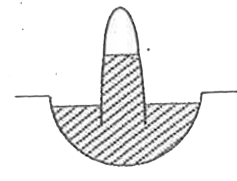
If this expriment uses water instead of mercury , then
A. length of water will be equal to 76 cm
B. length of water will be less than 76 cm
C. length of water will be greater than 76 cm
D. none of the above
View SolutionTorricelli was the first do devise an experiment for measuring atmospheric pressure . He took calibrated hard glass tube , 1 m in lengt and of uniform cross section , closed at one end . He filled the whole tube with dry mercury taking care than no air or water droplets remain inside the tube , closed the opposite end of the tube tightly with thumb and inverted it . He put this inverted mercury tube into a mercury through , taking care that the end of the tube remains inside the mercury through , An interesting thing was noticed . Mercury in the tube fell down at first and then stopped at a particular position . The height was 76 cm above the free surface of mercury in the through . When the given tube was inclined or lowered in the mercury trough , the vertical haight of mercury level in the tube was always found constant .
Torricelli explained this by saying that the free surface of mrcury in the trough . Hence , the hydrostatic pressure exerted by the trough measures the atmospheric pressure .

If a small hole is made at point P in the barometer tube , then
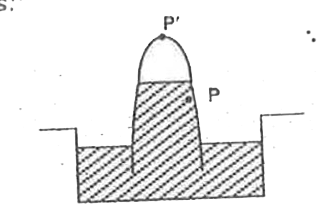
View Solution
Knowledge Check
The Physician Assistant Will See You Now
23 The term “paramedics” refers to health care workers who provide routine and clinical services.–––––––––––––––––––––––––––––––––––––––––––––––––––––––––––––––––––––––––––––––––––––––––––––––––––––– While the pressures of an aging population, insurance reforms, and health epidemics have increased demand for care, the supply of physicians is not expected to 24 keep pace.––––––––––– The Association of American Medical Colleges predicts a shortage of over 90,000 physicians by 2020, by 2025, that number could climb to more than 130,000. In some parts of the country, shortages are already a sad fact of life. A 2009 report by the Bureau of Health Professions notes that although a fifth of the US population lives in rural areas, less than a tenth of US physicians serves that population. Because a traditionalist response to the crisis— 25 amping up–––––––––––– medical-college enrollments and expanding physician training programs—is too slow and costly to address the near-term problem, alternatives are being explored. One promising avenue has been greater reliance on physician assistants (PAs).
26 By virtue of 27 there–––––– medical training, PAs can perform many of the jobs traditionally done by doctors, including treating chronic and acute conditions, performing minor 28 surgeries: and––––––––––––––– prescribing some medications. However, although well 29 compensated earning in 2012 a median annual salary of $90,930,––––––––––––––––––––––––––––––––––––––––––––––––––––––––––––––––––––– PAs cost health care providers less than do the physicians who might otherwise undertake these tasks. Moreover, the training period for PAs is markedly shorter than 30 those for–––––––––– physicians—two to three years versus the seven to eleven required for physicians.
Physician assistants already offer vital primary care in many locations. Some 90,000 PAs were employed nationwide in 2012. Over and above their value in partially compensating for the general physician shortage has been their extraordinary contribution to rural health care. A recent review of the scholarly literature by Texas researchers found that PAs lend cost-efficient, widely appreciated services in underserved areas. 31 In addition,––––––––––––– rural-based PAs often provide a broader spectrum of such services than do their urban and suburban counterparts, possibly as a consequence of the limited pool of rural-based physicians.
Increasingly, PAs and other such medical practitioners have become a critical complement to physicians. A 2013 RAND Corporation report estimates that while the number of primary care physicians will increase slowly from 2010 to 2025, the number of physician assistants and nurse-practitioners in primary care will grow at much faster rates. 32 Both by merit and from necessity, PAs are likely to greet more 33 patience than––––––––––––––– ever before.
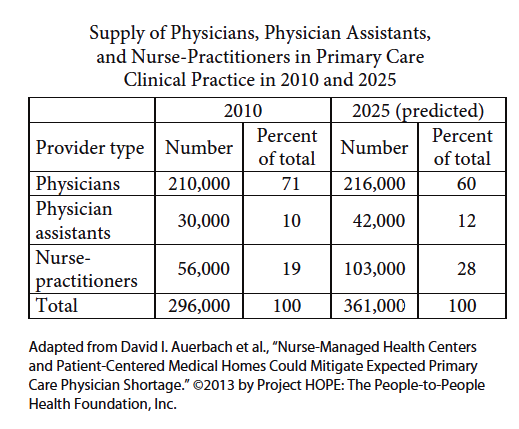 ANO CHANGEBmaintain the tempo.Cget in line.Dmove along.
ANO CHANGEBmaintain the tempo.Cget in line.Dmove along.The Physician Assistant Will See You Now
23 The term “paramedics” refers to health care workers who provide routine and clinical services.–––––––––––––––––––––––––––––––––––––––––––––––––––––––––––––––––––––––––––––––––––––––––––––––––––––– While the pressures of an aging population, insurance reforms, and health epidemics have increased demand for care, the supply of physicians is not expected to 24 keep pace.––––––––––– The Association of American Medical Colleges predicts a shortage of over 90,000 physicians by 2020, by 2025, that number could climb to more than 130,000. In some parts of the country, shortages are already a sad fact of life. A 2009 report by the Bureau of Health Professions notes that although a fifth of the US population lives in rural areas, less than a tenth of US physicians serves that population. Because a traditionalist response to the crisis— 25 amping up–––––––––––– medical-college enrollments and expanding physician training programs—is too slow and costly to address the near-term problem, alternatives are being explored. One promising avenue has been greater reliance on physician assistants (PAs).
26 By virtue of 27 there–––––– medical training, PAs can perform many of the jobs traditionally done by doctors, including treating chronic and acute conditions, performing minor 28 surgeries: and––––––––––––––– prescribing some medications. However, although well 29 compensated earning in 2012 a median annual salary of $90,930,––––––––––––––––––––––––––––––––––––––––––––––––––––––––––––––––––––– PAs cost health care providers less than do the physicians who might otherwise undertake these tasks. Moreover, the training period for PAs is markedly shorter than 30 those for–––––––––– physicians—two to three years versus the seven to eleven required for physicians.
Physician assistants already offer vital primary care in many locations. Some 90,000 PAs were employed nationwide in 2012. Over and above their value in partially compensating for the general physician shortage has been their extraordinary contribution to rural health care. A recent review of the scholarly literature by Texas researchers found that PAs lend cost-efficient, widely appreciated services in underserved areas. 31 In addition,––––––––––––– rural-based PAs often provide a broader spectrum of such services than do their urban and suburban counterparts, possibly as a consequence of the limited pool of rural-based physicians.
Increasingly, PAs and other such medical practitioners have become a critical complement to physicians. A 2013 RAND Corporation report estimates that while the number of primary care physicians will increase slowly from 2010 to 2025, the number of physician assistants and nurse-practitioners in primary care will grow at much faster rates. 32 Both by merit and from necessity, PAs are likely to greet more 33 patience than––––––––––––––– ever before.
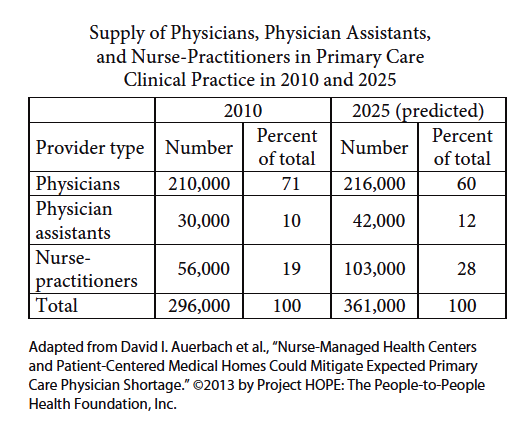 ANO CHANGEBsurgeries, andCsurgeries, and,Dsurgeries, and
ANO CHANGEBsurgeries, andCsurgeries, and,Dsurgeries, andThe Physician Assistant Will See You Now
23 The term “paramedics” refers to health care workers who provide routine and clinical services.–––––––––––––––––––––––––––––––––––––––––––––––––––––––––––––––––––––––––––––––––––––––––––––––––––––– While the pressures of an aging population, insurance reforms, and health epidemics have increased demand for care, the supply of physicians is not expected to 24 keep pace.––––––––––– The Association of American Medical Colleges predicts a shortage of over 90,000 physicians by 2020, by 2025, that number could climb to more than 130,000. In some parts of the country, shortages are already a sad fact of life. A 2009 report by the Bureau of Health Professions notes that although a fifth of the US population lives in rural areas, less than a tenth of US physicians serves that population. Because a traditionalist response to the crisis— 25 amping up–––––––––––– medical-college enrollments and expanding physician training programs—is too slow and costly to address the near-term problem, alternatives are being explored. One promising avenue has been greater reliance on physician assistants (PAs).
26 By virtue of 27 there–––––– medical training, PAs can perform many of the jobs traditionally done by doctors, including treating chronic and acute conditions, performing minor 28 surgeries: and––––––––––––––– prescribing some medications. However, although well 29 compensated earning in 2012 a median annual salary of $90,930,––––––––––––––––––––––––––––––––––––––––––––––––––––––––––––––––––––– PAs cost health care providers less than do the physicians who might otherwise undertake these tasks. Moreover, the training period for PAs is markedly shorter than 30 those for–––––––––– physicians—two to three years versus the seven to eleven required for physicians.
Physician assistants already offer vital primary care in many locations. Some 90,000 PAs were employed nationwide in 2012. Over and above their value in partially compensating for the general physician shortage has been their extraordinary contribution to rural health care. A recent review of the scholarly literature by Texas researchers found that PAs lend cost-efficient, widely appreciated services in underserved areas. 31 In addition,––––––––––––– rural-based PAs often provide a broader spectrum of such services than do their urban and suburban counterparts, possibly as a consequence of the limited pool of rural-based physicians.
Increasingly, PAs and other such medical practitioners have become a critical complement to physicians. A 2013 RAND Corporation report estimates that while the number of primary care physicians will increase slowly from 2010 to 2025, the number of physician assistants and nurse-practitioners in primary care will grow at much faster rates. 32 Both by merit and from necessity, PAs are likely to greet more 33 patience than––––––––––––––– ever before.

Which choice is the best introduction to the paragraph?ANO CHANGEBFor many Americans, finding a physician is likely to become a growing challenge.CGetting treatment for an illness usually requires seeing either a general practitioner or a specialist.DWorldwide the costs of health care are increasing at an alarming rate.
Why do tyres have a better griop of the road while going on a level road than while going on an incline?
View SolutionWhy is it better to use a divider than a ruler, while measuring the length of a line segment?
View SolutionThe human ciculatory system can be thought of as a closed system of interconnecting pipes through which fluid is continuously circulated by two pumps the two pumps the right and left verticles of the heart, work as simple two-stroke force pumps. The muscles of the heart regulate the force by contracting and relaxing. the contraction (systole) lasts about 0.2s and a complete systole/diastole (contraction/relaxation) cycle lasts about 0.8s. For flood pressures and speeds in the normal range. the volume flow rate of blood through a blood vessel is directly proportional tot he pressure difference over a length of the vessel and to the fourth power of the radius of the vessel. The total mechanical energy per unit volume of blood just as it leaves the heart is E/V=ρgh+P+ρv2
Q. Why is diastolic blood pressure muchh lower than systolic pressure?
A. because the heart exerts more force on the blood during diastole
B. Because the heart exerts no force on the blood during diastole
C. Because the radii of the blood vessels increase during diastole while the force exerted by the heart on the blood remains the same.
D. Because the radii of the blood vessels increase during diastole while the force exerted by the heart on the blood remains the same.
View SolutionTorricelli was the first do devise an experiment for measuring atmospheric pressure . He took calibrated hard glass tube , 1 m in lengt and of uniform cross section , closed at one end . He filled the whole tube with dry mercury taking care than no air or water droplets remain inside the tube , closed the opposite end of the tube tightly with thumb and inverted it . He put this inverted mercury tube into a mercury through , taking care that the end of the tube remains inside the mercury through , An interesting thing was noticed . Mercury in the tube fell down at first and then stopped at a particular position . The height was 76 cm above the free surface of mercury in the through . When the given tube was inclined or lowered in the mercury trough , the vertical haight of mercury level in the tube was always found constant .
Torricelli explained this by saying that the free surface of mercury in the trough . Hence , the hydrostatic pressure exerted by the trough measures the atmospheric pressure .
If an additional hole is also made at P ' at the top point of the tube , then

A. mercury will not come out of the tube
B. mercury may come out of the tube after some time .
C. mercury will come out of the tube instantly
D. none of these
View SolutionThe Physician Assistant Will See You Now
23 The term “paramedics” refers to health care workers who provide routine and clinical services.–––––––––––––––––––––––––––––––––––––––––––––––––––––––––––––––––––––––––––––––––––––––––––––––––––––– While the pressures of an aging population, insurance reforms, and health epidemics have increased demand for care, the supply of physicians is not expected to 24 keep pace.––––––––––– The Association of American Medical Colleges predicts a shortage of over 90,000 physicians by 2020, by 2025, that number could climb to more than 130,000. In some parts of the country, shortages are already a sad fact of life. A 2009 report by the Bureau of Health Professions notes that although a fifth of the US population lives in rural areas, less than a tenth of US physicians serves that population. Because a traditionalist response to the crisis— 25 amping up–––––––––––– medical-college enrollments and expanding physician training programs—is too slow and costly to address the near-term problem, alternatives are being explored. One promising avenue has been greater reliance on physician assistants (PAs).
26 By virtue of 27 there–––––– medical training, PAs can perform many of the jobs traditionally done by doctors, including treating chronic and acute conditions, performing minor 28 surgeries: and––––––––––––––– prescribing some medications. However, although well 29 compensated earning in 2012 a median annual salary of $90,930,––––––––––––––––––––––––––––––––––––––––––––––––––––––––––––––––––––– PAs cost health care providers less than do the physicians who might otherwise undertake these tasks. Moreover, the training period for PAs is markedly shorter than 30 those for–––––––––– physicians—two to three years versus the seven to eleven required for physicians.
Physician assistants already offer vital primary care in many locations. Some 90,000 PAs were employed nationwide in 2012. Over and above their value in partially compensating for the general physician shortage has been their extraordinary contribution to rural health care. A recent review of the scholarly literature by Texas researchers found that PAs lend cost-efficient, widely appreciated services in underserved areas. 31 In addition,––––––––––––– rural-based PAs often provide a broader spectrum of such services than do their urban and suburban counterparts, possibly as a consequence of the limited pool of rural-based physicians.
Increasingly, PAs and other such medical practitioners have become a critical complement to physicians. A 2013 RAND Corporation report estimates that while the number of primary care physicians will increase slowly from 2010 to 2025, the number of physician assistants and nurse-practitioners in primary care will grow at much faster rates. 32 Both by merit and from necessity, PAs are likely to greet more 33 patience than––––––––––––––– ever before.
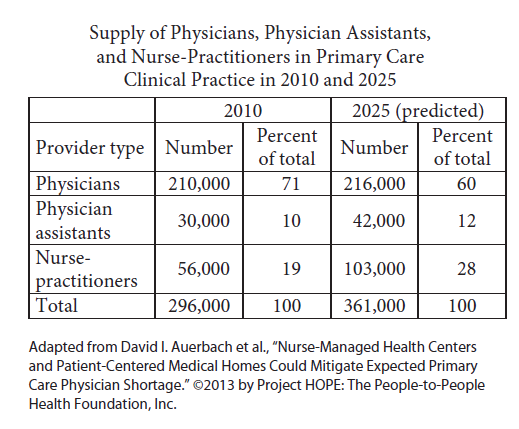
View Solution
